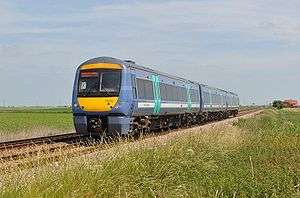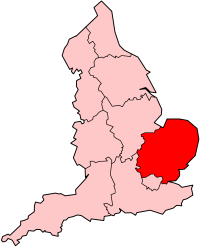Ely–Peterborough line
| Ely–Peterborough line | |
|---|---|
 National Express East Anglia Class 170 Turbostar near Turves in 2010 | |
| Overview | |
| Type | Heavy rail |
| System | National Rail |
| Status | Operational |
| Locale | Cambridgeshire, England |
| Termini |
Ely 52°23′28″N 0°15′59″E / 52.3910°N 0.2665°E Peterborough 52°34′29″N 0°15′00″W / 52.5746°N 0.2499°W |
| Stations | 3 not counting Ely and Peterborough |
| Operation | |
| Owner | Network Rail |
| Operator(s) |
CrossCountry East Midlands Trains Abellio Greater Anglia |
| Character | Secondary[1] |
| Rolling stock |
Class 170 "Turbostar" Class 158 "Sprinter" |
| Technical | |
| Number of tracks | Two |
| Track gauge | 4 ft 8 1⁄2 in (1,435 mm) standard gauge |
| Operating speed | 75 mph maximum |
| Ely–Peterborough line | |||||||||||||||||||||||||||||||||||||||||||||||||||||||||||||||||||||||||||||||||||||||||||||||||||||||||||||||||||||||||||||||||||||||||||||||||||||
|---|---|---|---|---|---|---|---|---|---|---|---|---|---|---|---|---|---|---|---|---|---|---|---|---|---|---|---|---|---|---|---|---|---|---|---|---|---|---|---|---|---|---|---|---|---|---|---|---|---|---|---|---|---|---|---|---|---|---|---|---|---|---|---|---|---|---|---|---|---|---|---|---|---|---|---|---|---|---|---|---|---|---|---|---|---|---|---|---|---|---|---|---|---|---|---|---|---|---|---|---|---|---|---|---|---|---|---|---|---|---|---|---|---|---|---|---|---|---|---|---|---|---|---|---|---|---|---|---|---|---|---|---|---|---|---|---|---|---|---|---|---|---|---|---|---|---|---|---|---|
| |||||||||||||||||||||||||||||||||||||||||||||||||||||||||||||||||||||||||||||||||||||||||||||||||||||||||||||||||||||||||||||||||||||||||||||||||||||
The Ely–Peterborough line is a railway line in England, linking East Anglia to the Midlands. It is a part of the Network Rail Strategic Route 5, SRS 05.07 and is classified as a secondary line.[1] It is used by a variety of inter-regional and local passenger services from East Anglia to the West Midlands and North West, as well as freight and infrastructure traffic; it also links with the busy East Coast Main Line at its western end. Fenland District council (the area's primary local authority) put forward their Rail Development Strategy for the route in 2012, which includes infrastructure upgrades for the intermediate stations, improved frequencies for the services using it (e.g. doubling the Birmingham New Street to Stansted Airport service to half-hourly and the Ipswich to Peterborough service to hourly) and establishing a Community Rail Partnership for the line in 2013/14.[2]
History
The line was originally opened by the Eastern Counties Railway company in 1847, linking the ECR mainline from London via Cambridge and Ely to Brandon and Norwich with Peterborough.[3] Trains initially terminated and started from Peterborough East, though a link to the Great Northern Railway's station was subsequently built to allow through running to the Midland Railway line to Leicester and the GNR main line to the north. Onward travel was also possible over two London and North Western Railway lines from Peterborough, to Rugby and Northampton whilst March would soon become a very busy junction with the opening of branches to Kings Lynn via Wisbech and Cambridge via St Ives (both by the ECR) in 1847/8 and the GNR route to Spalding in 1867. The latter two were subsequently jointly vested in the GER and GNR in 1879.
Many of the branches fell victim to the Beeching Axe in the early to mid 1960s, as did Peterborough East and several of the intermediate stations.[4] The March–Spalding line also closed in 1982 with the rundown of the marshalling yard at Whitemoor, leaving only the original main line in operation.
Service
_at_March_East_-_geograph.org.uk_-_1929716.jpg)
Passenger services are provided by CrossCountry, East Midlands Trains and Greater Anglia. To the west most trains continue beyond Peterborough to either Leicester and Birmingham New Street (via the Birmingham–Peterborough line), or to Nottingham, Sheffield, Manchester Piccadilly and Liverpool Lime Street. To the east most trains continue beyond Ely to Norwich or to Cambridge and Stansted Airport (joining in one direction or in the other the Cambridge–Norwich "Breckland" line) or to Ipswich. Connections are available for stations to Kings Lynn at Ely. Services used to run between London and Peterborough but these services were dropped in 2010.
The line is used extensively by freight trains from the Port of Felixstowe to the West Midlands, North West and Scotland, as it forms part of the Felixstowe to Nuneaton rail freight corridor that is being upgraded by Network Rail to allow more rail-borne freight from the port to be diverted away from the London area.[5]
Infrastructure
The line is double track throughout, has a loading gauge of W10 and a line speed of 40–75 mph. Apart from short stretches at each end, the line is not electrified.[1]
See also
References
- 1 2 3 "Route 5 – West Anglia" (PDF). Network Rail. Retrieved 2009-05-22.
- ↑ "Fenland Rail Development Strategy". Fenland District Council. Retrieved 2014-01-13.
- ↑ "Historical Background". Peterborough–Ely–Norwich RUG. Retrieved 2014-01-13.
- ↑ "Peterborough East". Disused Stations. Retrieved 2014-01-13.
- ↑ "Developing Rail Freight: Felixstowe–Nuneaton" (PDF). Network Rail. 2012-03-02. Retrieved 2014-01-13.
